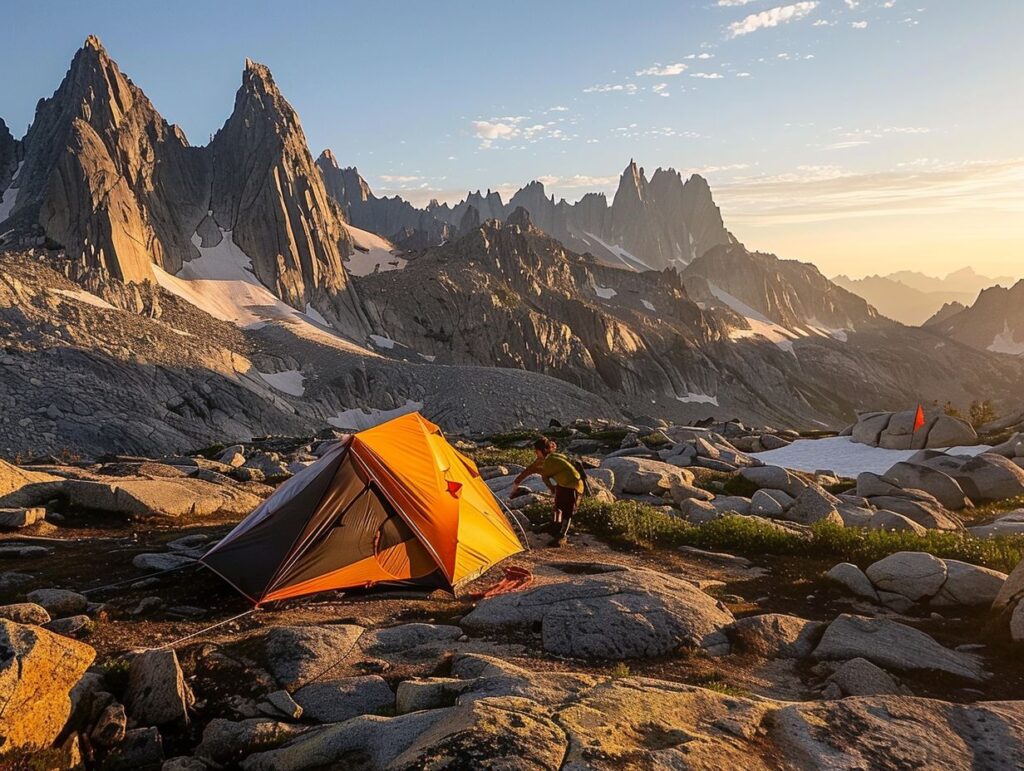Looking to take your camping adventures to the next level? Camping in rocky terrain offers a unique and thrilling experience for outdoor enthusiasts. From the breathtaking scenery to the sense of seclusion and challenge it provides, rocky terrain camping is truly an adventure like no other.
Before you head out, it’s important to be prepared with the right gear and supplies. We explore the essential items you need, as well as some helpful tips for setting up camp and staying safe in rocky terrain. Get ready to embrace the rugged beauty of nature and embark on a rocky terrain camping trip of a lifetime!
Key Takeaways:
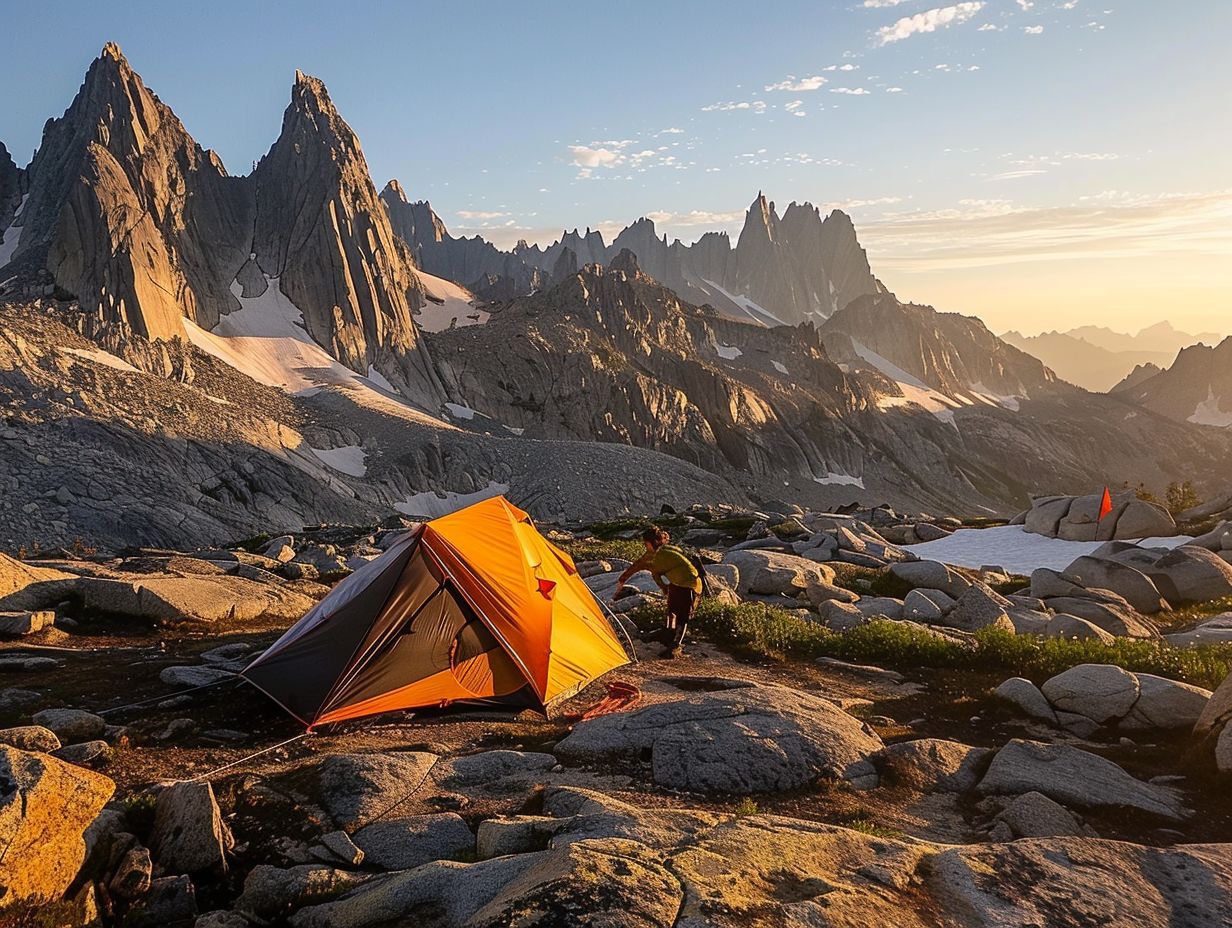
- Choose Rocky Terrain for Unique Scenery, Privacy and Adventure
- Essential Gear: Sturdy Tent, Sleeping Bag and Pad, Proper Footwear, Navigation Tools, First Aid Kit, Water and Food, Cooking Supplies, Lighting Equipment, Personal Hygiene Items
- Tips for Setting Up Camp: Find a Flat Surface, Clear Rocks and Debris, Use Rocks to Secure Tent and Gear, Consider Wind Direction
What Are the Essential Gear and Supplies for Camping in Rocky Terrain?
When camping in rocky terrain, it is essential to be properly equipped with the required gear and supplies to ensure a safe and comfortable experience.
1. Sturdy Tent
When camping in rocky terrain, it is essential to have a sturdy tent that can provide secure and reliable shelter against the challenging elements. Durability is a crucial factor to consider when choosing a tent for rocky terrain. Opt for tents made of strong materials that are capable of withstanding rough surfaces.
Features such as colour-coded poles and quick-clip systems can facilitate easy setup, saving time and effort in demanding environments. Stability is paramount to prevent the tent from collapsing on rocky ground. Look for tent designs with robust pole structures and guy ropes to provide additional support in windy conditions.
2. Sleeping Bag and Sleeping Pad
Proper equipment, such as a high-quality sleeping bag and sleeping mat, is essential for both comfort and insulation while camping on rough terrain.
Choosing the right sleeping bag is crucial for ensuring a peaceful night’s sleep in the countryside. It is advisable to choose a sleeping bag with excellent thermal insulation properties to retain warmth during cold weather conditions. Moreover, a well-designed sleeping mat plays a crucial role in providing padding, which helps relieve discomfort from uneven surfaces and encourages a refreshed awakening.
It is advisable to go for a sleeping mat that provides sufficient thickness and support for a superior level of comfort. When used together, these two items create a cosy shelter that protects against the elements, allowing campers to fully enjoy their outdoor adventure.
3. Appropriate Footwear
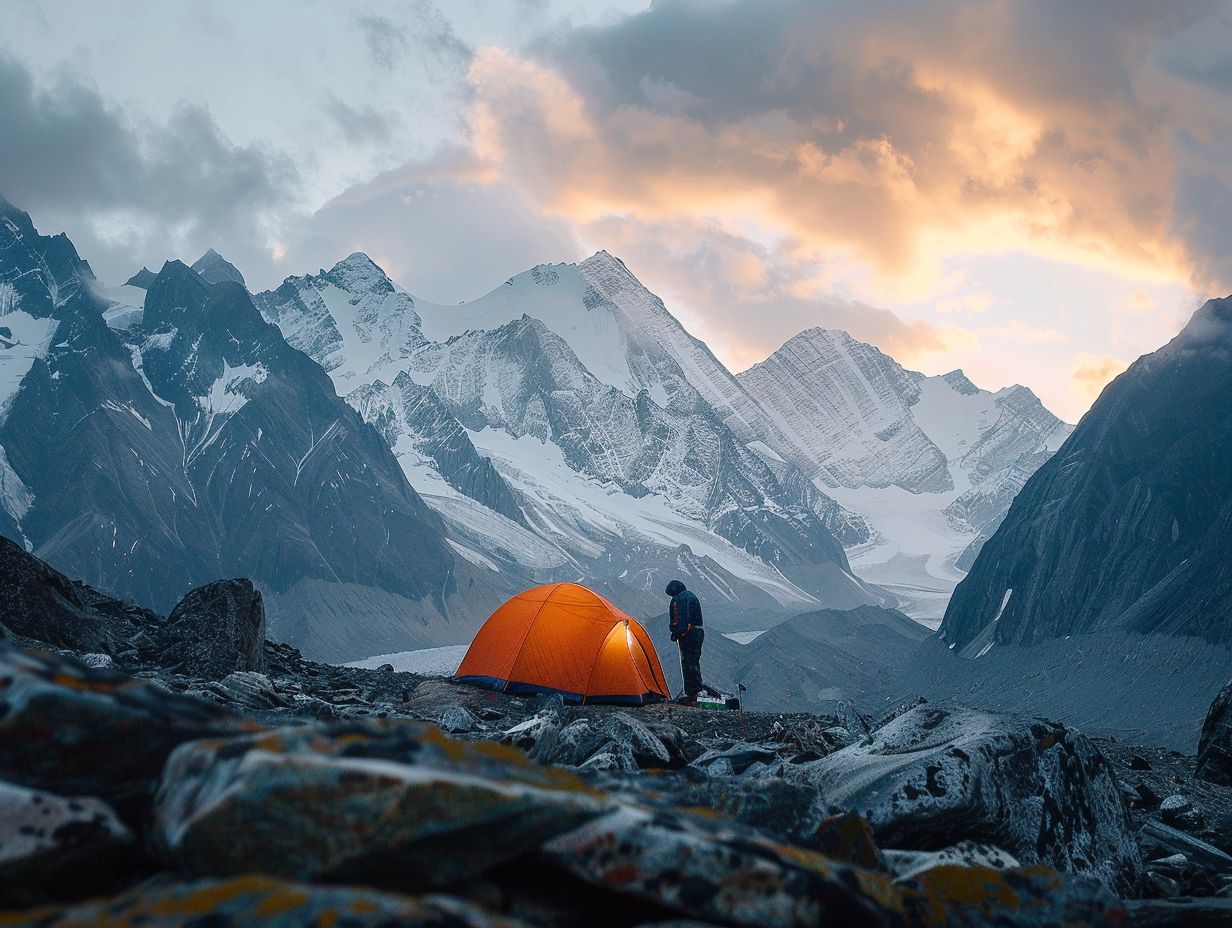
Wearing suitable footwear is essential when traversing rocky terrain, as it offers the required support and stability necessary for hiking. In the absence of appropriate shoes or boots, hikers face the possibility of discomfort, potential injuries, and an increased risk of losing their balance on uneven ground.
When navigating rocky terrains, selecting footwear with strong ankle support is essential to reduce the occurrence of twists or sprains. Furthermore, footwear with a reliable grip is vital for maintaining traction on slippery surfaces, thus ensuring a safer hiking expedition.
In addition, durability plays a crucial role, as rough terrains can quickly damage weak footwear. Therefore, investing in high-quality, durable footwear specifically designed for rocky conditions can greatly improve the hiker’s performance and overall enjoyment of the outdoor adventure.
4. Navigation Tools
Adequate navigation equipment, including maps, compasses, and GPS devices, is imperative for the secure traversal of rugged terrains.
The pivotal function of these tools is to assist explorers in orienting themselves within challenging landscapes. Maps afford a visual depiction of the surroundings, enabling hikers to judiciously plan their itinerary. Compasses furnish a definitive sense of direction, particularly in scenarios of limited visibility or the absence of prominent landmarks.
GPS devices furnish real-time positional information, facilitating accurate location tracking. The prudent utilisation of these tools not only ensures a successful expedition but also bolsters individuals’ confidence in navigating unfamiliar territories proficiently.
5. First Aid Kit
It is imperative to have a comprehensive first aid kit when camping in rocky terrains to effectively manage injuries and emergencies. Key items to include in a camping first aid kit for such terrains are adhesive plasters, antiseptic wipes, gauze dressings, tweezers, scissors, a thermometer, painkillers, blister treatment, and personal medicines.
Along with these essentials, it is vital to have items such as a resuscitation mask, emergency blanket, triangular bandage, gloves, and a torch. These items enable individuals to proficiently address common injuries like cuts, grazes, burns, strains, and insect bites that may occur outdoors.
Considering the inclusion of a first aid manual is recommended to offer guidance in delivering appropriate care during unforeseen situations.
6. Water and Food
It is imperative to ensure an ample supply of water and food to maintain hydration and nourishment during a camping excursion in rugged terrains.
Exploration of rocky terrains entails significant physical exertion and exposure to the elements, which can rapidly deplete the body of essential nutrients and fluids. To sustain optimal performance and prevent dehydration, it is advised to carry an adequate quantity of clean water and nutrient-dense snacks.
Regarding water purification, the utilisation of portable filtration systems or water purification tablets is recommended to guarantee the availability of safe drinking water. Opting for lightweight and non-perishable food options, such as nuts, trail mix, energy bars, and dehydrated meals, is advisable. These provisions offer sustained energy levels and are convenient for packing during outdoor excursions.
7. Cooking Supplies
Proper meal preparation during camping necessitates the presence of appropriate cooking supplies, which includes a portable stove and utensils.
Portable stoves offer the advantage of enabling cooking activities in any location, independent of the availability of a conventional stove or electricity. Essential utensils such as a durable knife, cutting board, pots, and pans are critical for both food preparation and cooking tasks. Additionally, the presence of storage containers for leftover food and ingredients is crucial.
The use of suitable cookware guarantees uniform cooking and effective heat distribution, contributing to the desired taste and quality of the meals prepared. The combination of the correct utensils and a portable stove facilitates outdoor cooking and dining experiences with optimal convenience.
8. Lighting Equipment
Effective lighting equipment, such as head torches and hurricane lamps, plays a crucial role in ensuring visibility and safety during nocturnal activities.
Head torches offer a convenient hands-free lighting solution, particularly suited for pursuits like hiking, running, or camping, enabling users to maintain a clear line of sight while keeping their hands unencumbered.
Conversely, hurricane lamps deliver ambient illumination to a camping site, facilitating easy navigation while establishing a warm and inviting atmosphere.
Both variants of lighting apparatus are critical for outdoor enthusiasts engaging in nighttime excursions, furnishing dependable light sources that augment visibility and heighten the safety and enjoyment of nocturnal adventures.
9. Personal Hygiene Items
It is imperative to maintain sanitation and cleanliness while camping in remote rocky terrains by carrying personal hygiene items. Personal hygiene plays a pivotal role in ensuring a comfortable and healthy camping experience.
Essential items such as biodegradable soap, hand sanitizer, eco-friendly wet wipes, toothbrush, toothpaste, and deodorant should be included in the camping essentials.
Adequate personal hygiene not only aids in preventing illnesses but also enhances morale and overall well-being during outdoor excursions. Moreover, in addition to toiletries, segregating a separate bag for dirty clothes and carrying rubbish disposal bags are crucial steps in ensuring the cleanliness of the campsite.
By emphasizing hygiene practices, campers can fully engage in the natural beauty of their surroundings without compromising their health and comfort.
What Are Some Tips for Setting Up Camp in Rocky Terrain?
Establishing a campsite in rough terrain requires careful planning and preparation to ensure the safety and stability of the area.
1. Find a Flat and Stable Surface
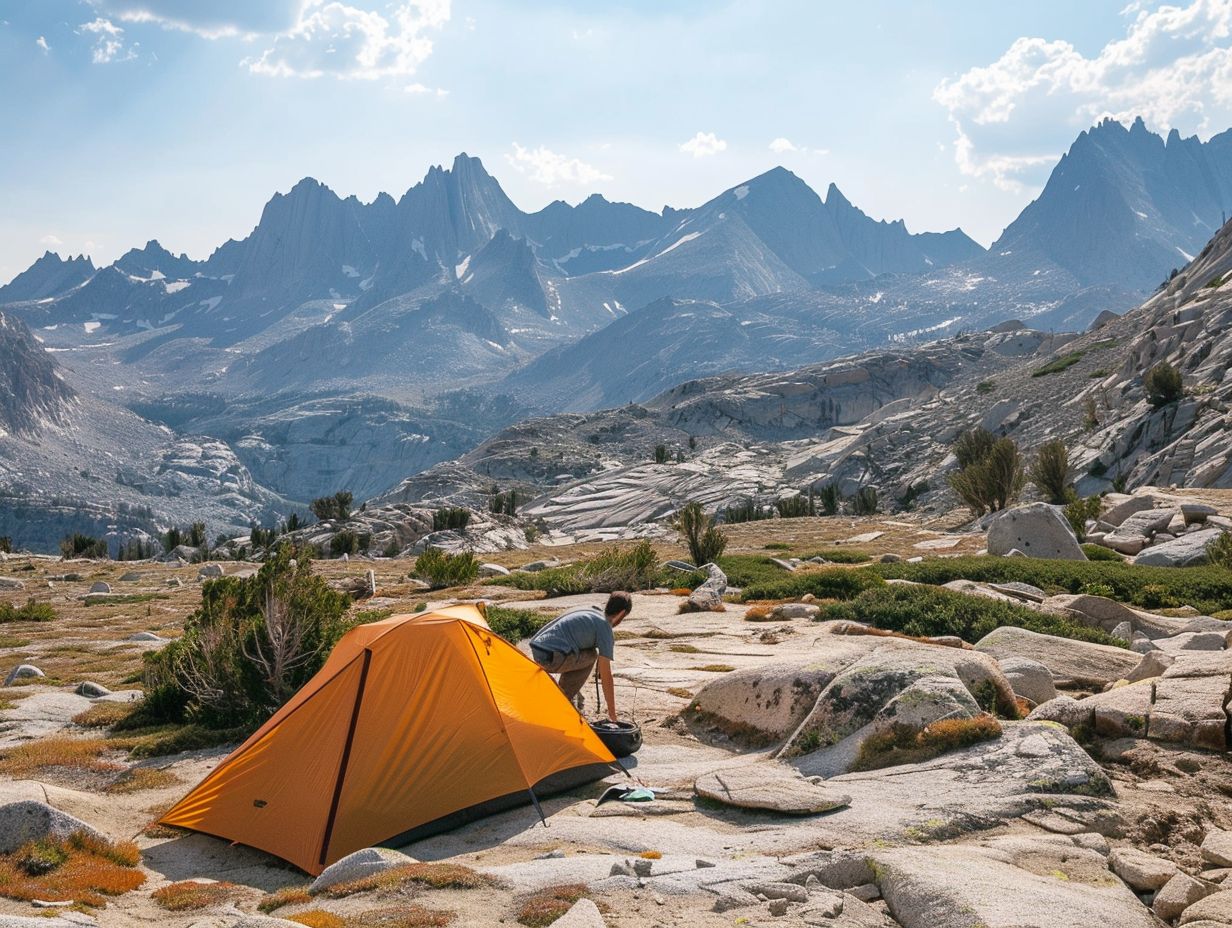
The initial step in ensuring a secure and comfortable tent setup is locating a flat and stable surface. Inappropriate terrain can result in uneven sleeping surfaces, discomfort, and the possibility of water pooling in the event of rain.
To determine a suitable location, individuals should seek out areas with minimal slopes or inclines. Additionally, it is advisable to inspect for any rocks, roots, or debris that could cause discomfort or damage to the tent floor. Selecting areas that are not susceptible to flooding or runoff during rainfall is also recommended.
Furthermore, individuals should take into account the natural direction of the wind and position the tent to optimise airflow while reducing exposure to strong gusts. By prioritising stability and comfort in the camping setup, individuals can significantly enhance their outdoor experience.
2. Clear the Area of Rocks and Debris
Ahead of establishing the tent, it is essential to clear the area of rocks and debris to establish a smooth and safe surface conducive to camping activities. This preparatory measure is crucial in ensuring a comfortable camping experience for the occupants.
The process should commence by meticulously inspecting the ground for any sharp rocks or protruding branches that pose a threat of damaging the tent or sleeping gear. Employing a small shovel or rake, larger rocks and twigs ought to be removed from the site.
Subsequently, the surface should be smoothed out by gently levelling the ground either by foot or using a camping shovel. Attention must be given to the presence of tree roots or any uneven terrains that have the potential to cause discomfort during rest.
It is imperative to acknowledge that a well-prepared campsite not only enhances the quality of sleep but also mitigates the occurrence of safety hazards.
3. Use rocks to secure tent and gear
Utilise rocks effectively to anchor your tent and gear, ensuring they maintain stability and remain in position, particularly in windy conditions. When siting rocks around your tent, strategically place them at the corners of the tent and along the base of the pegs to achieve optimal stability. It is imperative to ensure that the rocks are firmly positioned against the fabric of the tent or the pegs to prevent any potential shifting.
For equipment such as rucksacks or cooking gear, arrange rocks around the items or place them on top to secure everything in its place. Additionally, consider constructing a perimeter of rocks around your campsite to bolster stability further and mitigate any unwanted movement of your gear.
4. Consider Wind Direction
It is important to always take into account the wind direction when establishing the placement of your tent to ensure maximum stability and to mitigate the impact of wind.
The correct positioning of your tent in relation to the direction of the wind can play a crucial role in enhancing your camping experience. By arranging your tent perpendicular to the prevailing wind direction, you can reduce wind resistance and improve the overall structural stability of the tent. This not only helps in preventing the tent from swaying or collapsing during strong winds but also contributes to a more comfortable interior environment.
Selecting a natural windbreak, such as dense shrubbery or a sturdy rock formation, can provide additional shielding from harsh gusts. By following these basic measures, you can significantly enhance your safety and enjoyment while engaged in camping activities.
How to Stay Safe While Camping in Rocky Terrain?
Staying secure while camping in rough terrain requires alertness and preparedness to deal with the unique challenges posed by such surroundings.
1. Watch Your Step
It is important to exercise caution and ensure stable footing in order to prevent slips and falls on uneven rocky terrain. The essential factor for safely traversing rocky terrain is maintaining continuous awareness of the surroundings and making intentional movements. It is advised to take small, meticulous steps and utilise hands for balance whenever necessary.
Equally distributing weight and thoroughly testing each foothold before proceeding are critical precautions. Additionally, one should remain vigilant of loose rocks or unstable surfaces, as they pose potential hazards. By adopting a slow and deliberate pace, individuals can confidently and successfully navigate even the most difficult rocky terrains.
2. Be Aware of Wildlife
It is imperative to have an awareness of wildlife in order to ensure personal safety, especially in rugged terrains where various animals and insects may inhabit.
Identifying indicators of wildlife presence, such as tracks, scat, or sounds, can assist in avoiding unforeseen encounters. It is crucial to bear in mind that wildlife should not be disturbed or approached closely.
While hiking or camping, it is essential to store food properly to avoid attracting animals. If there is encountering a wild animal, it is important to maintain a safe distance and refrain from attempting to feed or touch it. Respecting their habitats and behaviours, and adhering to the guidelines for wildlife interaction in the specific area being visited is paramount.
By cultivating a respectful and harmonious relationship with wildlife, individuals can admire their beauty while prioritising personal safety.
3. Keep Food and Rubbish Secure
Ensuring that food and rubbish are securely stored is imperative to avoid attracting wildlife and to uphold a safe campsite.
It is vital to store food items properly in airtight containers or bear-proof canisters to discourage hungry animals from entering your campsite. When disposing of rubbish, it is advisable to double bag it and place it in a secure location that is removed from your sleeping area.
By effectively managing food and waste, individuals not only safeguard the local wildlife from consuming harmful materials but also reduce the likelihood of perilous interactions between humans and animals. It is important to bear in mind that a tidy campsite is synonymous with a secure campsite.
4. Stay Hydrated and Protected from the Sun
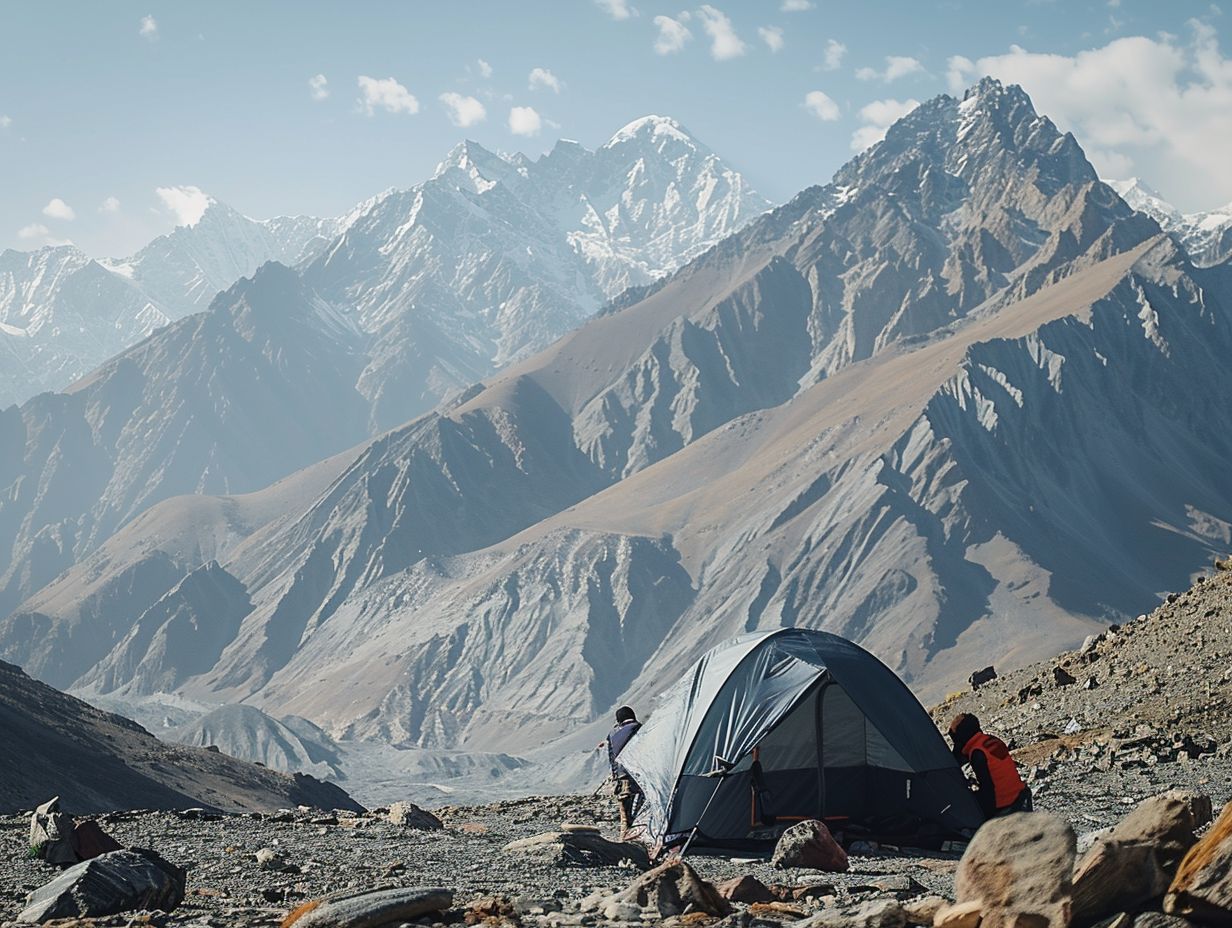
Remaining properly hydrated and safeguarding oneself from sun exposure are crucial preventative measures to mitigate dehydration and sunburn risks when camping in rugged terrain.
It is essential to ensure the availability of an ample water supply and electrolyte-infused beverages to maintain optimal hydration levels, particularly in warm and arid climates. The application of sunscreen with a high Sun Protection Factor (SPF) and the utilisation of protective clothing are effective strategies to shield the skin from harmful ultraviolet (UV) rays.
Proactive preparation by including essential items such as a refillable water bottle, a brimmed hat, and sunglasses in your gear will enhance your comfort and safety throughout your outdoor expedition. Remember to take periodic breaks in shaded locations and refrain from engaging in strenuous activities during peak sunlight hours to minimise the risk of heat-related illnesses.
5. Be Prepared for Changing Weather
Preparation for fluctuating weather conditions is imperative to ensure both safety and comfort during camping excursions in rocky terrain.
It is essential to adhere to various tips for weather readiness, including the necessity of checking the forecast prior to departure. Packing layers of clothing is crucial due to the potential fluctuations in temperature throughout the day.
Additionally, investing in a high-quality tent capable of withstanding wind and rain is critical. Ensuring access to a reliable source of weather information while in remote locations is also paramount.
Engaging in proactive planning measures, such as selecting a sheltered campsite and securing loose belongings that may be susceptible to displacement by strong winds, can significantly enhance the overall outdoor experience.
Frequently Asked Questions
What are some general tips for camping in rocky terrain?
1. Choose a sturdy tent that can withstand uneven ground and rocks.
2. Bring a sleeping pad or air mattress for extra cushioning.
3. Wear sturdy and comfortable hiking boots for exploring the rocky terrain.
4. Always have a map and compass on hand to navigate the rocky terrain.
5. Be mindful of potential hazards such as loose rocks and steep inclines.
6. Pack a first aid kit in case of any injuries while navigating the rocky terrain.
How should I set up my campsite in rocky terrain?
1. Look for a flat, even spot free of loose rocks to pitch your tent.
2. Use rocks or logs to anchor your tent and prevent it from blowing away.
3. Avoid setting up camp near rocky ledges or steep drops.
4. Keep a safe distance from any boulders that may potentially fall due to weather conditions.
5. Clear away any debris or rocks from your campsite to create a comfortable space.
6. Use guy lines to secure your tent and prevent it from being blown away by strong winds.
What should I bring for cooking in rocky terrain?
1. A sturdy camping stove and fuel to cook your meals.
2. Bring pre-cut and pre-prepared food to avoid the need for sharp knives on the rocky terrain.
3. Use a flat rock or portable grill as a makeshift cooking surface.
4. Bring a small shovel or trowel to clear away any rocks or debris from your cooking area.
5. Consider bringing a lightweight and collapsible table to create a flat surface for cooking and eating.
6. Always properly dispose of any food waste to avoid attracting wild animals to your campsite.
What safety precautions should I take when camping in rocky terrain?
1. Always wear proper hiking and camping gear, including sturdy boots and a helmet.
2. Stay alert and be mindful of potential hazards such as loose rocks and steep drops.
3. Bring a first aid kit and know how to treat common injuries like cuts and sprains.
4. Keep a safe distance from the edge of any cliffs or rocky ledges.
5. Never climb on or near unstable rocks or boulders.
6. Inform someone of your planned route and expected return time before heading out to explore.
What are some fun activities to do while camping in rocky terrain?
1. Hiking and exploring the rocky terrain to discover unique rock formations and scenic views.
2. Rock climbing for a thrilling and challenging experience.
3. Stargazing at night away from city lights.
4. Photography to capture the unique landscape and wildlife.
5. Fishing in nearby streams or lakes.
6. Relaxing and enjoying the peacefulness of nature.
What should I do in case of inclement weather while camping in rocky terrain?
1. Always check the weather forecast before heading out and be prepared for changing conditions.
2. Seek shelter immediately if lightning or thunder is present.
3. Secure your tent and belongings to prevent them from blowing away in strong winds.
4. Be cautious of flash floods and avoid camping near dry river beds.
5. Bring waterproof gear and clothing to stay dry in case of rain.
6. Consider rescheduling your trip if severe weather is forecasted.

